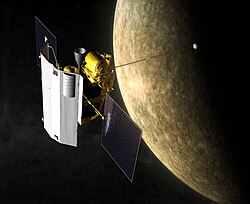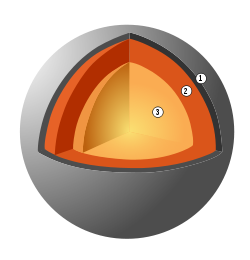MESSENGER looking Toward the South Pole of Mercury
Text from the original image release:
One week ago, on January 14, 2008, the MESSENGER spacecraft passed 200 kilometers (124 miles) above the surface of Mercury and snapped the first pictures of a side of Mercury not previously seen by spacecraft. This image shows that previously unseen side, with a view looking toward Mercury's south pole. The southern limb of the planet can be seen in the bottom right of the image. The bottom left of the image shows the transition from the sunlit, day side of Mercury to the dark, night side of the planet, a transition line known as the terminator. In the region near the terminator, the sun shines on the surface at a low angle, causing the rims of craters and other elevated surface features to cast long shadows, accentuating height differences in the image. A raised crater rim that is just catching the last glint of sunlight can be seen prominently in this terminator region.
This image is just one in a planned sequence of 42 images acquired by the Narrow Angle Camera (NAC) of the Mercury Dual Imaging System (MDIS). From these 42 images, the MESSENGER team is creating a high-resolution mosaic image of this previously unseen portion of Mercury. In total during the flyby, MDIS took more than 1200 images, which are being combined to create multiple mosaics with different resolutions and of different portions of the planet. The creation of high-resolution mosaic images will enable a global view of Mercury's surface and will be used to understand the geologic processes that made Mercury the planet we see today.
This image was acquired about 98 minutes after MESSENGER's closest approach to Mercury, when the spacecraft was at a distance of about 33,000 kilometers (21,000 miles).
Mission Elapsed Time (MET) of image: 108830711
Additional notes:
Relevantní obrázky
Relevantní články
Merkur (planeta)Merkur je Slunci nejbližší a současně i nejmenší planetou sluneční soustavy, dosahuje pouze 140 % velikosti zemského Měsíce a je menší než Jupiterův měsíc Ganymed a Saturnův Titan. Merkur nemá žádný měsíc. Jeho oběžná dráha je ze všech planet nejblíže ke Slunci a jeden oběh trvá pouze 87,969 dne. Dráha Merkuru má největší výstřednost dráhy ze všech planet sluneční soustavy a sama planeta má nejmenší – téměř nulový – sklon rotační osy. Během dvou oběhů kolem Slunce dojde ke třem otočením kolem rotační osy. Perihelium jeho dráhy se stáčí ke Slunci o 43 vteřin za století; fenomén, který ve 20. století vysvětlil Albert Einstein obecnou teorií relativity. Při pohledu ze Země dosahuje Merkur jasnosti mezi -2,0 až 5,5m, takže je viditelný i pouhým okem, ale jelikož se nikdy nevzdaluje od Slunce dále než na 28,3°, je většinu roku těžko pozorovatelný. Nejlepší podmínky nastávají při ranním a večerním soumraku, kdy se slunce nachází pod horizontem. .. pokračovat ve čtení

















